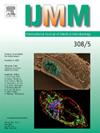德国某大学医院高致病性肺炎克雷伯菌的流行、特点及临床特征
IF 3.6
3区 医学
Q1 MICROBIOLOGY
引用次数: 0
摘要
高致病性肺炎克雷伯菌(hvKp)引起的感染通常以严重、转移性和复发性感染为特征。这种病型最初在亚洲发现,现在已扩展到世界各地。高毒力与多药耐药相结合的趋同菌株进一步加剧了这种情况。然而,关于hvKp在欧洲国家的发生只有稀疏的数据。因此,本研究调查了hvKp在德国三级医疗中心的流行情况。对2022年6月1日至8月31日在格赖夫斯瓦尔德大学医学院采集的临床标本中分离的肺炎菌进行前瞻性采集。只考虑每位患者的第一个分离株,而排除筛查样本。所有分离株均具有毒力表型特征,并进行了全基因组测序(WGS)。结果共检出122株分离株,表型从大部分抗生素敏感型到多药耐药型不等,仅有1株携带碳青霉烯酶基因(blaOXA-181)。表型分析显示异质性结果,只有一个分离株在串试验和粘液染色板中显示同时阳性。WGS显示了81种不同的序列类型,包括高危克隆谱系。四株分离株携带与高毒力相关的典型遗传标记,并且大部分对抗生素敏感。在mellonella感染模型中,这四种分离株的幼虫死亡率高于两种碳青霉烯耐药的典型肺炎克雷伯菌。未发现趋同菌株。结论122株分离株中有4株(3.3 %)为hvKp。由于这种病型引起的感染过程具有众所周知的侵袭性,这种患病率似乎与临床相关。本文章由计算机程序翻译,如有差异,请以英文原文为准。
Prevalence, characteristics and clinical features of hypervirulent Klebsiella pneumoniae in a German university hospital
Background
Infections caused by hypervirulent Klebsiella pneumoniae (hvKp) are often characterised by severe, metastatic and relapsing infections. Initially described in Asia, this pathotype has now expanded worldwide. Convergent strains combining hypervirulence with multidrug resistance additionally aggravate the situation. However, only sparse data are available on the occurrence of hvKp in European countries. Therefore, this study investigated the prevalence of hvKp in a tertiary medical centre in Germany.
Methods
K. pneumoniae isolates were prospectively collected from clinical specimens obtained at the University Medicine Greifswald from June 1st to August 31st, 2022. Only the first isolate from each patient was considered, while screening samples were excluded. All isolates were phenotypically characterised for virulence and subjected to whole genome sequencing (WGS).
Results
A total of 122 isolates were included, which ranged from largely antibiotic-susceptible to multidrug-resistant phenotypes, with only one isolate carrying a carbapenemase gene (blaOXA-181). Phenotypic assays showed heterogeneous results, with only one isolate demonstrating concomitant positivity in both the string test and mucoid-staining plate. WGS revealed 81 different sequence types, including high-risk clonal lineages. Four isolates carried typical genetic markers associated with hypervirulence and were largely antibiotic-susceptible. In the Galleria mellonella infection model, these four isolates showed higher larval mortality compared to two control carbapenem-resistant classical K. pneumoniae strains. Convergent strains were not found.
Conclusion
Our findings revealed that 3.3 % (4 out of 122) of isolates were classified as hvKp. This prevalence appears clinically relevant due to the notoriously aggressive course of infections caused by this pathotype.
求助全文
通过发布文献求助,成功后即可免费获取论文全文。
去求助
来源期刊
CiteScore
9.70
自引率
0.00%
发文量
18
审稿时长
45 days
期刊介绍:
Pathogen genome sequencing projects have provided a wealth of data that need to be set in context to pathogenicity and the outcome of infections. In addition, the interplay between a pathogen and its host cell has become increasingly important to understand and interfere with diseases caused by microbial pathogens. IJMM meets these needs by focussing on genome and proteome analyses, studies dealing with the molecular mechanisms of pathogenicity and the evolution of pathogenic agents, the interactions between pathogens and host cells ("cellular microbiology"), and molecular epidemiology. To help the reader keeping up with the rapidly evolving new findings in the field of medical microbiology, IJMM publishes original articles, case studies and topical, state-of-the-art mini-reviews in a well balanced fashion. All articles are strictly peer-reviewed. Important topics are reinforced by 2 special issues per year dedicated to a particular theme. Finally, at irregular intervals, current opinions on recent or future developments in medical microbiology are presented in an editorial section.

 求助内容:
求助内容: 应助结果提醒方式:
应助结果提醒方式:


